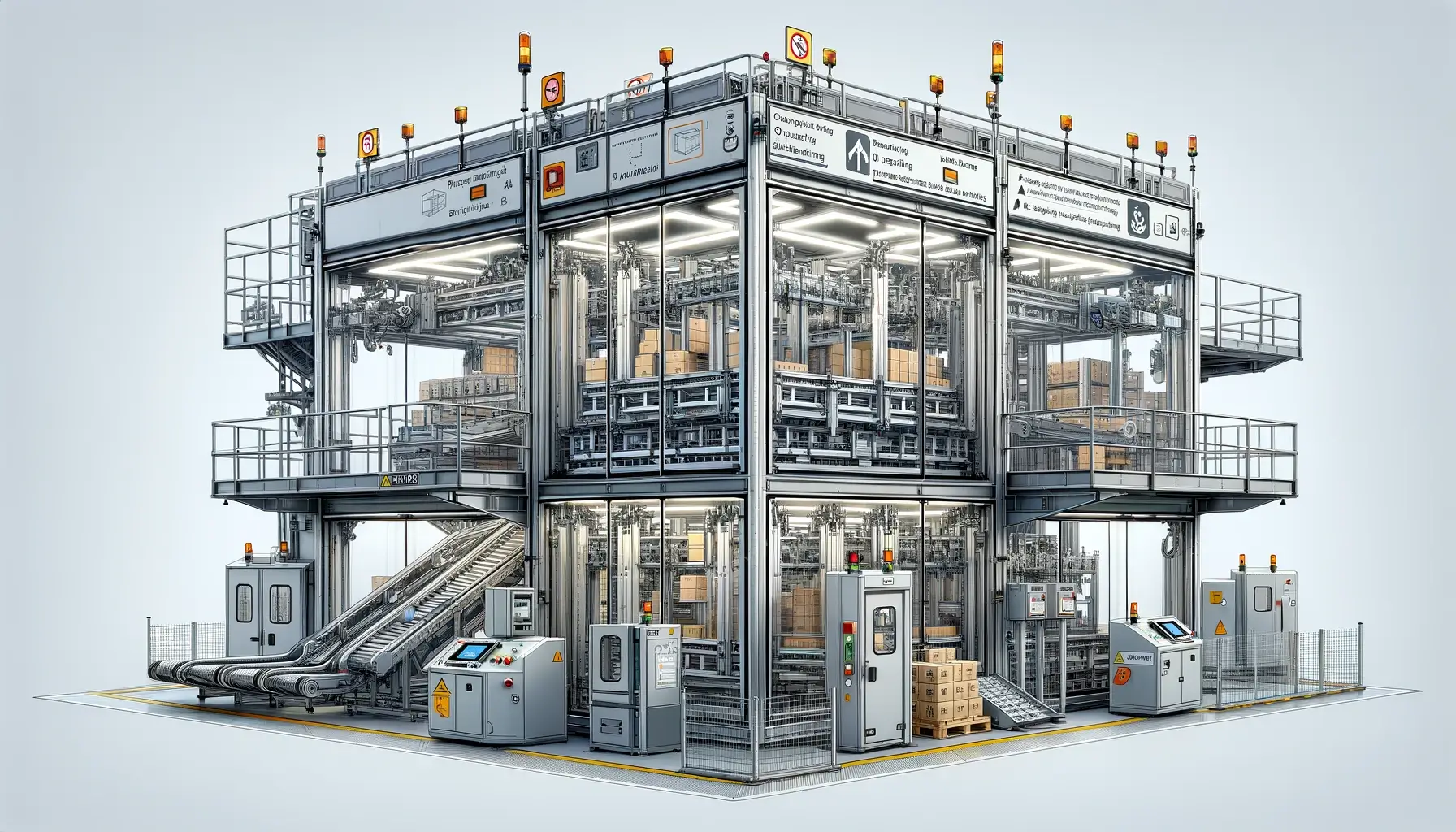Efficient palletizing is vital for logistics and manufacturing. It helps products move safely through supply chains. This report covers the basics of palletizing. It looks at strategies for integrating automated systems. It also discusses ways to optimize both manual and automated palletizing operations. These best practices help businesses improve operations, cut costs, and boost workplace safety. This way, products also arrive at their destination safely.
What is Palletizing?
Palletizing stacks products on pallets for transport and storage. This step is vital in packaging lines in many industries. This key part of logistics and warehousing helps manage goods well. It organizes products to use space better and keeps loads stable.
The Foundation: Pallets
The heart of palletizing is the pallet. It’s a flat structure that holds goods. Equipment like forklifts, pallet jacks, front loaders, or cranes lift it. Most pallets can carry loads of up to 1,000 kg (2,200 lb).
Standardizing pallets has changed shipping. It makes containerization more efficient. It also replaces older methods, like wooden boxes and barrels.
Palletizing Methods
Palletizing operations generally fall into three categories:
Manual Palletizing: Workers physically stack products onto pallets by hand. This method offers flexibility but is time-consuming, physically demanding, and increases injury risk. The main benefit is that it needs little equipment. This makes it the least expensive choice for low-volume work.
Semi-Automated Palletizing: A cost-effective step up from manual methods. One operator manages all tasks. This method needs little training. It also keeps pallet patterns flexible and works at floor level. Plus, it cuts down on physical strain.
Automated Palletizing uses machines like robotic or regular palletizers to stack products. This process increases speed and consistency while lowering the risk of injury. This method becomes essential for high-volume operations seeking maximum efficiency.
Integrating Palletizers into Production Lines
Integrating automated palletizers into production lines needs careful planning. This helps ensure everything runs smoothly. The following steps outline a comprehensive approach to successful palletizer integration:
1. Understanding Your Palletizing Needs
Before beginning integration, thoroughly assess your specific requirements:
- Evaluate product characteristics (size, shape, weight) being palletized
- Determine required production rate (products per hour)
- Understand packaging and stacking pattern requirements
- Measure available installation space within your production line
These factors help you pick the best palletizer for your needs. They also guide you on how to integrate it.
2. Selecting the Appropriate Palletizer
Based on your requirements, choose from these palletizer types:
Conventional Palletizers are great for fast operations. They work best with uniform products. These machines build layers, ensuring both speed and reliability.
Robotic Palletizers: They offer more flexibility for different products and packaging types. This is helpful for operations that often change packaging sizes and pallet patterns.
Semi-Automatic Palletizers: Great for smaller operations that want to save money. They’re perfect when full automation is not needed or too expensive.
Schneider’s integrated palletizers provide different levels of automation. They use components like conveyors, shuttle carts, and dispensers. Also, they include labelers and stretch wrappers to reduce operator involvement.
3. Planning the Integration Process
Develop a thorough integration plan:
- Assess your current production line to identify areas requiring modification
- Collaborate with palletizer manufacturers or experienced integrators on optimal layout and placement
- Create a realistic implementation timeline including installation, testing, and employee training
- Prepare the installation area with necessary structural modifications and power supply
4. Installation and Setup
Proper installation is critical for system success:
- Place the palletizer in the marked area. Make sure it is level and firmly anchored.
- Calibrate the palletizer by setting up palletizing patterns and adjusting conveyor speeds
- Conduct thorough testing with different scenarios before full integration
With Robotiq’s palletizing system, you can decide how to orient boxes. You can also choose where to grip them and how to stack them on pallets. This is all done easily through the user interface.
5. Training Your Team
Comprehensive training ensures effective operation:
- Train operators on equipment usage, pattern selection, and monitoring
- Provide maintenance staff with knowledge for routine maintenance and troubleshooting
- Ensure all team members understand safety protocols
6. Integration with Production Line
Integrate gradually for minimal disruption:
- Begin with a partial integration to identify and resolve issues
- Monitor performance closely during initial phases
- Optimize processes based on performance data
- Scale up to full production gradually
7. Maintenance and Continuous Improvement
Establish ongoing maintenance protocols:
- Implement daily inspections for wear and potential issues
- Maintain a regular cleaning schedule for sensors and moving parts
- Follow manufacturer-recommended maintenance schedules
- Continuously assess and improve performance as production needs evolve
Optimizing Manual Palletizing
While automation offers significant benefits, many operations continue to utilize manual palletizing. These strategies can substantially improve manual palletizing efficiency:
1. Standardize Work Procedures
Create consistency in your manual palletizing operations:
- Establish clear protocols and guidelines for stacking to ensure uniformity
- Train workers thoroughly on optimized stacking techniques
- Implement visual guides and documentation for reference
2. Implement Ergonomic Solutions
Reduce physical strain and injury risk:
- Train workers on proper lifting techniques to prevent injuries
- Provide ergonomic aids like lift tables that raise pallets to comfortable working heights
- Consider pallet lift tables to maintain ergonomic working positions throughout the palletizing process
3. Optimize Stacking Techniques
Follow proven pallet loading methods:
- Place heaviest boxes on the bottom of the pallet for stability
- Stack boxes in columns. Make sure they align directly over each other. This helps maximize compression strength.
- Avoid interlocking boxes, which can reduce strength by up to 50%
- Don’t create overhangs or stacks in pyramid shapes, which compromise stability
4. Use Proper Support Materials
Enhance stability with appropriate materials:
- Use slip sheets to guard the cargo at the bottom of the pallet. They help stop compression strength loss.
- Apply stretch wrap to secure loads and prevent shifting during transport
- Implement strapping for additional security, especially for items over 150 pounds
- Keep banding close to the load to minimize damage potential
5. Balance Workflow and Personnel Management
Create sustainable working conditions:
- Rotate tasks among workers to reduce fatigue from repetitive motions
- Schedule adequate rest periods to maintain productivity and reduce error rates
- Allocate tasks based on worker strengths to optimize performance
6. Consider Transitioning to Semi-Automated Solutions
Evaluate cost-effective automation options:
- Semi-automatic palletizing offers an economical upgrade from fully manual processes
- One operator can manage all operations with minimal training required
- These systems provide complete flexibility in pallet patterns while reducing physical strain
Optimizing Palletizing Efficiency
These strategies can boost palletizing efficiency, no matter if you use:
- Manual systems
- Semi-automated systems
- Fully automated systems
1. Optimize Packaging Design
Start efficiency improvements at the packaging level:
- Select lightweight yet durable materials to maximize pallet capacity
- Consider customizing packaging to fit efficiently on standard pallet sizes
- Use compression-resistant materials that enable secure stacking without product damage
- Standardize packaging dimensions when possible to simplify palletizing patterns
2. Select Appropriate Pallet Types
Match pallet specifications to your specific needs:
- Choose block pallets for heavy loads. They are stronger. Stringer pallets are lightweight and better for less demanding tasks.
- Consider material options (wood, plastic, metal) based on application requirements
- Evaluate pallet dimensions that align with your storage systems and transportation methods
3. Implement Advanced Software Solutions
Leverage technology for pattern optimization:
- Schneider’s OptiStak software lets operators quickly change patterns. They can also optimize configurations right from the HMI.
- Robotiq’s palletizing solution offers pattern configuration capabilities that simplify setup and operation
- Use software to find stacking patterns that make the best use of space and keep loads stable.
4. Conduct Regular Workflow Analysis
Continuously evaluate and improve processes:
- Track the entire palletizing process from product arrival to pallet completion
- Identify bottlenecks and inefficiencies in the workflow
- Review equipment performance regularly and address issues promptly
- Time each stage of the process to identify opportunities for improvement
5. Consider Automation Benefits
Evaluate the potential advantages of automated systems:
- Increased speed and productivity enables meeting tight deadlines and handling larger orders
- Reduced labor costs through minimal supervision requirements
- Enhanced accuracy and precision reduces product damage and improves customer satisfaction
- Greater flexibility and scalability allows adapting to changing market conditions
6. Implement Data-Driven Optimization
Use information systems to enhance operations:
- Harness connected systems and comprehensive data to optimize palletizing processes
- Analyze performance metrics to identify improvement opportunities
- Implement predictive maintenance based on equipment performance data
7. Optimize Pallet Patterns
Use efficient stacking configurations:
- Column stacking (boxes directly aligned) maximizes vertical strength and stability
- Ensure proper spacing between items to accommodate minor gripping imperfections
- Consider layer alternation patterns for improved interlocking without compromising strength
- Leave adequate space between boxes when using automated systems to prevent jams
Useful Table Summarizing
| Integration Phase | Key Actions | Details / Tips |
|---|---|---|
| 1. Assess Palletizing Needs | – Evaluate product types, sizes, weights, and pallet patterns – Analyze current production line layout | Identify bottlenecks, conveyor compatibility, space constraints, and throughput requirements |
| 2. Select Palletizer Type | – Choose between conventional, robotic, cobot, or semi-automatic palletizers | Consider flexibility, load capacity, safety requirements, and ease of programming |
| 3. Plan Integration | – Collaborate with equipment manufacturers or integrators – Develop timeline and layout plans | Include installation, testing, employee training, and downtime minimization |
| 4. Prepare Installation Site | – Ensure structural readiness – Verify power supply and safety measures | May require floor anchoring, electrical upgrades, and workspace clearance |
| 5. Install and Configure | – Position and anchor palletizer – Connect power and control systems (PLCs, WMS) – Calibrate system | Set palletizing patterns, conveyor speeds, and robotic arm alignment |
| 6. Test and Soft Launch | – Run initial production with limited scope – Monitor for jams, misalignments, and inefficiencies | Adjust parameters based on performance data before full-scale deployment |
| 7. Train Operators and Staff | – Provide hands-on training on operation, safety, and maintenance | Focus on pattern changes, emergency procedures, and routine upkeep |
| 8. Full Integration and Scale | – Expand palletizer use to full production volume – Continuously monitor KPIs and system performance | Use data to optimize pallet patterns, cycle times, and throughput |
| 9. Maintenance and Continuous Improvement | – Schedule regular inspections and maintenance – Update software and retrain staff as needed | Prevent downtime, extend equipment lifespan, and adapt to changing production needs |



Leave a Reply